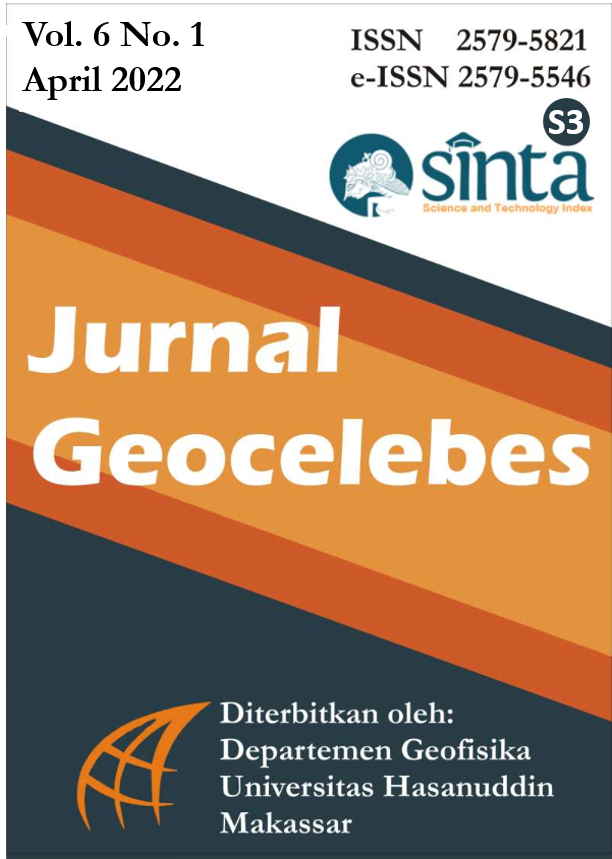Biostratigraphy of Limestone based on Large Foraminifera in the Donggala Region, Central Sulawesi
Biostratigrafi Batugamping Berdasarkan Kandungan Foraminifera Besar di Daerah Donggala, Sulawesi Tengah
DOI:
https://doi.org/10.20956/geocelebes.v6i1.19949Keywords:
large foraminifera, limestone, Sulawesi Molasa FormationAbstract
The Sulawesi Molasa Formation is mostly composed of clastic and carbonate sediments which are widely distributed on the island of Sulawesi. Research on the Sulawesi Molasa Formation has been carried out by several researchers. However, there has been no detailed research on limestone biostratigraphy in the Donggala area, so it is very important to do it. This study aims to analyze the age and depositional environment of the Sulawesi Molasa Formation limestone based on the content of large foraminifera. The method used in data collection is measuring section. Field data collection was carried out by stratigraphic measurements including lithology identification, thickness and rock sampling. Laboratory observations were carried out using a polarizing microscope to observe a thin section of rock to determine the species of large foraminifera, their mineral and organic compositions. From the results of field observations found four types of lithology, namely wackestone, packstone, grainstone and floatstone. Based on the observation of large foraminifera fossils in a thin section of limestone in the study area, there are 24 species of large foraminifera identified. Among them, there are four index fossils, namely Miogypsinoides dehaarti (van der Vlerk), Paleomiogypsina bononensis (Matsumaru), Miogypsina sp, (Vaughan), Paleomiogypsina sp, and Miogypsinella sp, (Aquitanian). Based on age withdrawal and description of large foraminifera fossils, it is known that the limestones of the study area are Early Miocene-Middle Miocene age with the depositional environment in the lagoon zone to the forereef shelf
References
Adam, C.G. 1970. A Reconsideration of The East Indian Letter Classification of The Tertiary. Bulletin of The British Museum (Natural History) Geology. 19(3), pp.1-137.
BouDagher-Fadel, M.K. 2008). Evolution and Geological Significance of Larger Benthic Foraminifera. 1st ed. Amsterdam: Elsevier.
Dunham, R.J. 1962. Classification of Carbonate Rock According to Depositional Texture, in Ham, W.E. (ed.), Depositional Environment in Carbonate Rock. AAPG Memoir 1, pp.108-121. https://doi.org/10.1306/M1357
Embry, A.F. and Klovan, J.E. 1971. A Late Devonian reef tract on Northeastern Banks Island, N.W.T1. Bulletin of Canadian Petroleum Geology. 19(4), pp.730–781. https://doi.org/10.35767/gscpgbull.19.4.730
Lunt, P. and Allan, T., 2004. A History and Application of Larger Foraminifera in Indonesian Biostratigraphy, Calibrated to Isotopic Dating. Geology Research Development Centre Museum, Bandung, Workshop on Micropaleontology, 109p.
Maulana, A. 2019. Petrologi. Yogyakarta: Penerbit Ombak.
Pringgoprawiro, H. and Kapid, R. 2000. Foraminifera: Pengenalan Mikrofosil dan Aplikasi Biostratigrafi. Bandung: Penerbit ITB.
Sukamto, R., Sumardirdja, H., Suptandar, T., and Sudana, D. 1973. Peta Geologi Regional Lembar Palu. Bandung: Pusat Penelitian dan Pengembangan Geologi, Direktorat Jenderal Pertambangan Umum dan Energi.
Surono, and Hartono, U. 2013. Geologi Sulawesi. Jakarta: LIPI Press.
van der Vlerk, I.M. and Umbgrove, J.H.L. 1927. Tertiaire gidsforaminiferen uit Nederlandsch Oost-Indie. Wetenschappelijke Mededeelingen, Dienst Mijnbouw Bandoeng. 6, pp.1–31.
Wagner, C.W. 1964. Manual of Larger Foraminifera: Generic Determination and Stratigraphic Value. Bataafse Internationale Petroleum Maatschappij.
Downloads
Published
How to Cite
Issue
Section
License
Authors who publish with this journal agree to the following terms:
- Authors retain copyright and grant the journal right of first publication with the work simultaneously licensed under a Creative Commons Attribution License that allows others to share the work with an acknowledgement of the work's authorship and initial publication in this journal.
- Authors are able to enter into separate, additional contractual arrangements for the non-exclusive distribution of the journal's published version of the work (e.g., post it to an institutional repository or publish it in a book), with an acknowledgement of its initial publication in this journal.
- Authors are permitted and encouraged to post their work online (e.g., in institutional repositories or on their website) prior to and during the submission process, as it can lead to productive exchanges, as well as earlier and greater citation of published work (See The Effect of Open Access).





